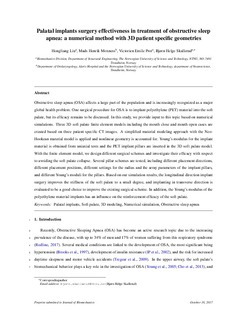| dc.contributor.author | Liu, Hongliang | |
| dc.contributor.author | Moxness, Mads Henrik Strand | |
| dc.contributor.author | Prot, Victorien Emile | |
| dc.contributor.author | Skallerud, Bjørn Helge | |
| dc.date.accessioned | 2019-02-19T08:39:14Z | |
| dc.date.available | 2019-02-19T08:39:14Z | |
| dc.date.created | 2017-11-17T14:18:08Z | |
| dc.date.issued | 2018 | |
| dc.identifier.citation | Journal of Biomechanics. 2018, 66 86-94. | nb_NO |
| dc.identifier.issn | 0021-9290 | |
| dc.identifier.uri | http://hdl.handle.net/11250/2586100 | |
| dc.description.abstract | Obstructive sleep apnea (OSA) affects a large percentage of the population and is increasingly recognized as a major global health problem. One surgical procedure for OSA is to implant polyethylene (PET) material into the soft palate, but its efficacy remains to be discussed. In this study, we provide input to this topic based on numerical simulations. Three 3 dimensional (3D) soft palate finite element models including mouth-close and mouth-open cases were created based on three patient-specific computed tomography (CT) images. A simplified material modeling approach with the Neo-Hookean material model was applied, and nonlinear geometry was accounted for. Young’s modulus for the implant material was obtained from uniaxial tests, and the PET implant pillars were inserted to the 3D soft palate model. With the finite element model, we designed different surgical schemes and investigated their efficacy with respect to avoiding the soft palate collapse. Several pillar schemes were tested, including different placement directions, different placement positions, different settings for the radius and the array parameters of the implant pillars, and different Young’s moduli for the pillars. Based on our simulation results, the longitudinal-direction implant surgery improved the stiffness of the soft palate to a small degree, and implanting in the transverse direction was evaluated to be a good choice for improving the existing surgical scheme. In addition, the Young’s modulus of the polyethylene material implants has an influence on the reinforcement efficacy of the soft palate. | nb_NO |
| dc.language.iso | eng | nb_NO |
| dc.publisher | Elsevier | nb_NO |
| dc.rights | Attribution-NonCommercial-NoDerivatives 4.0 Internasjonal | * |
| dc.rights.uri | http://creativecommons.org/licenses/by-nc-nd/4.0/deed.no | * |
| dc.title | Palatal implant surgery effectiveness in treatment of obstructive sleep apnea: a numerical method with 3D patient-specific geometries | nb_NO |
| dc.title.alternative | Palatal implant surgery effectiveness in treatment of obstructive sleep apnea: a numerical method with 3D patient-specific geometries | nb_NO |
| dc.type | Journal article | nb_NO |
| dc.type | Peer reviewed | nb_NO |
| dc.description.version | acceptedVersion | nb_NO |
| dc.source.pagenumber | 86-94 | nb_NO |
| dc.source.volume | 66 | nb_NO |
| dc.source.journal | Journal of Biomechanics | nb_NO |
| dc.identifier.doi | 10.1016/j.jbiomech.2017.11.006 | |
| dc.identifier.cristin | 1515377 | |
| dc.relation.project | Norges forskningsråd: 231741 | nb_NO |
| dc.description.localcode | © 2017. This is the authors’ accepted and refereed manuscript to the article. This manuscript version is made available under the CC-BY-NC-ND 4.0 license http://creativecommons.org/licenses/by-nc-nd/4.0/ | nb_NO |
| cristin.unitcode | 194,64,45,0 | |
| cristin.unitcode | 194,65,30,0 | |
| cristin.unitname | Institutt for konstruksjonsteknikk | |
| cristin.unitname | Institutt for nevromedisin og bevegelsesvitenskap | |
| cristin.ispublished | true | |
| cristin.fulltext | preprint | |
| cristin.qualitycode | 2 | |

